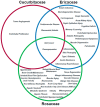Modulation of Cytoskeleton, Protein Trafficking, and Signaling Pathways by Metabolites from Cucurbitaceae, Ericaceae, and Rosaceae Plant Families
- PMID: 36355554
- PMCID: PMC9698530
- DOI: 10.3390/ph15111380
Modulation of Cytoskeleton, Protein Trafficking, and Signaling Pathways by Metabolites from Cucurbitaceae, Ericaceae, and Rosaceae Plant Families
Abstract
One promising frontier within the field of Medical Botany is the study of the bioactivity of plant metabolites on human health. Although plant metabolites are metabolic byproducts that commonly regulate ecological interactions and biochemical processes in plant species, such metabolites also elicit profound effects on the cellular processes of human and other mammalian cells. In this regard, due to their potential as therapeutic agents for a variety of human diseases and induction of toxic cellular responses, further research advances are direly needed to fully understand the molecular mechanisms induced by these agents. Herein, we focus our investigation on metabolites from the Cucurbitaceae, Ericaceae, and Rosaceae plant families, for which several plant species are found within the state of Florida in Hillsborough County. Specifically, we compare the molecular mechanisms by which metabolites and/or plant extracts from these plant families modulate the cytoskeleton, protein trafficking, and cell signaling to mediate functional outcomes, as well as a discussion of current gaps in knowledge. Our efforts to lay the molecular groundwork in this broad manner hold promise in supporting future research efforts in pharmacology and drug discovery.
Keywords: Cucurbitaceae; Ericaceae; Rosaceae; cytoskeleton; protein trafficking; signaling.
Conflict of interest statement
The authors declare that they have no conflict of interest.
Figures











Similar articles
-
Metabolite fingerprinting, pathway analyses, and bioactivity correlations for plant species belonging to the Cornaceae, Fabaceae, and Rosaceae families.Plant Cell Rep. 2016 Sep;35(9):1917-31. doi: 10.1007/s00299-016-2006-y. Epub 2016 Jun 25. Plant Cell Rep. 2016. PMID: 27344340
-
Variability in the production of tannins and other polyphenols in cell cultures of 12 Nordic plant species.Planta. 2017 Aug;246(2):227-241. doi: 10.1007/s00425-017-2686-8. Epub 2017 Apr 5. Planta. 2017. PMID: 28382519 Free PMC article.
-
Tapinanthus species: A review of botany and biology, secondary metabolites, ethnomedical uses, current pharmacology and toxicology.J Ethnopharmacol. 2022 Oct 5;296:115462. doi: 10.1016/j.jep.2022.115462. Epub 2022 Jun 15. J Ethnopharmacol. 2022. PMID: 35714877 Review.
-
In vitro antiviral activity of a series of wild berry fruit extracts against representatives of Picorna-, Orthomyxo- and Paramyxoviridae.Nat Prod Commun. 2014 Jan;9(1):51-4. Nat Prod Commun. 2014. PMID: 24660461
-
Comparison between tumors in plants and human beings: Mechanisms of tumor development and therapy with secondary plant metabolites.Phytomedicine. 2019 Nov;64:153081. doi: 10.1016/j.phymed.2019.153081. Epub 2019 Sep 3. Phytomedicine. 2019. PMID: 31568956 Review.
Cited by
-
Deep-Sea Sponges and Corals off the Western Coast of Florida-Intracellular Mechanisms of Action of Bioactive Compounds and Technological Advances Supporting the Drug Discovery Pipeline.Mar Drugs. 2023 Nov 28;21(12):615. doi: 10.3390/md21120615. Mar Drugs. 2023. PMID: 38132936 Free PMC article. Review.
References
-
- Dhyani P., Quispe C., Sharma E., Bahukhandi A., Sati P., Attri D.C., Szopa A., Sharifi-Rad J., Docea A.O., Mardare I., et al. Anticancer potential of alkaloids: A key emphasis to colchicine, vinblastine, vincristine, vindesine, vinorelbine and vincamine. Cancer Cell Int. 2022;22:206. doi: 10.1186/s12935-022-02624-9. - DOI - PMC - PubMed
-
- Da Silva T.C., da Silva J.M., Ramos M.A. What Factors Guide the Selection of Medicinal Plants in a Local Pharmacopoeia? A Case Study in a Rural Community from a Historically Transformed Atlantic Forest Landscape. Evid. Based Complement. Alternat. Med. 2018;2018:2519212. doi: 10.1155/2018/2519212. - DOI - PMC - PubMed
-
- Kew RBG State of the World’s Plants 2017. Royal Botanic Gardens, Kew. 2017. [(accessed on 31 August 2022)]. Available online: https://stateoftheworldsplants.org/
Publication types
Grants and funding
LinkOut - more resources
Full Text Sources

